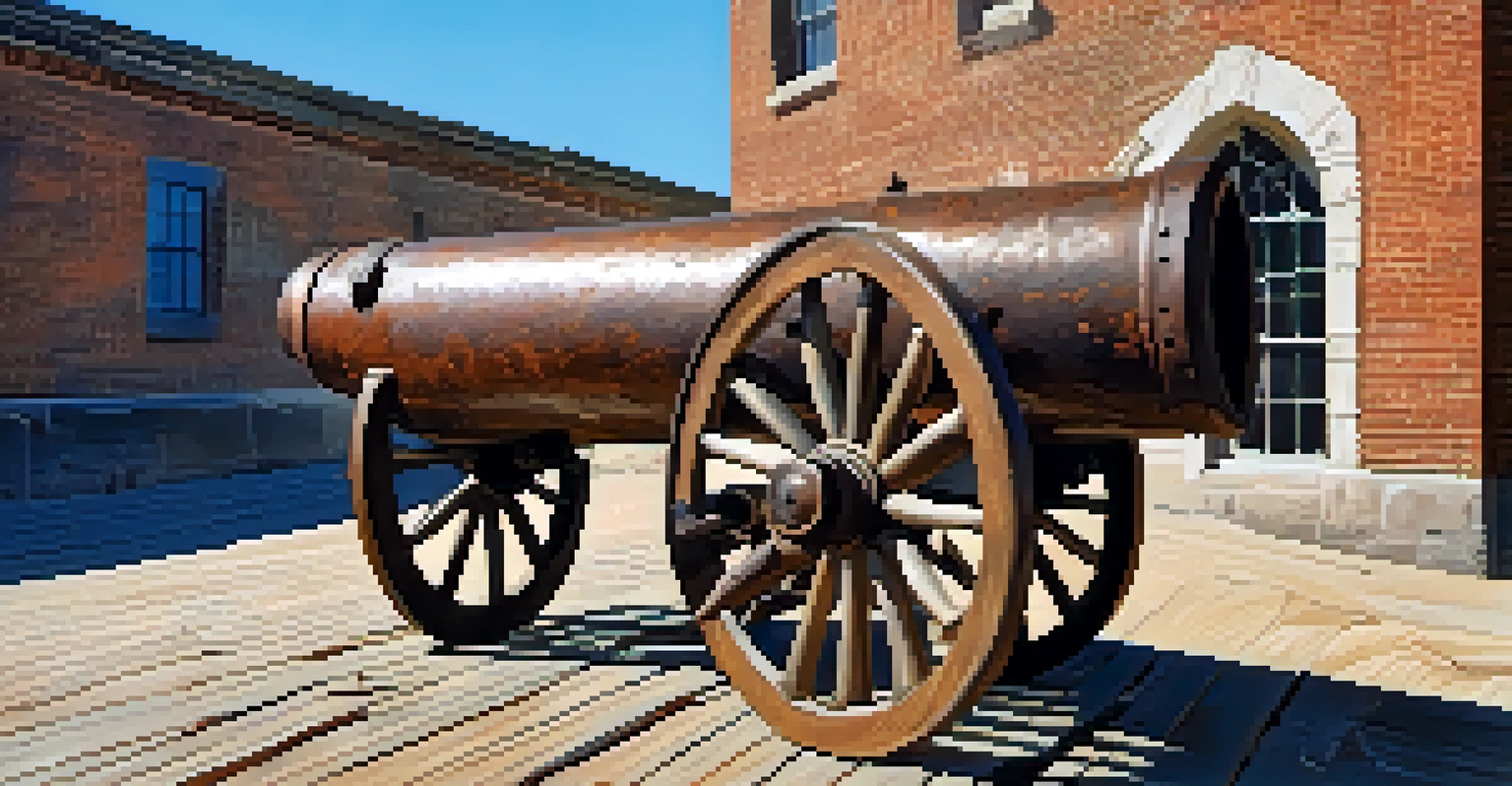The Story of Fort Brooke: Tampa's Military Heritage

Introduction to Fort Brooke: A Historical Overview
Fort Brooke, established in 1824, was a pivotal military outpost in Tampa, Florida. It served as a strategic point during the Second Seminole War and was crucial for the U.S. Army's operations in the region. This fortification not only protected settlers but also facilitated the movement of troops and supplies.
History is not a burden on the memory but an illumination of the soul.
As Tampa grew, Fort Brooke became a focal point of military activity, reflecting the turbulent times of the 19th century. The fort's location offered a vantage point that allowed for effective surveillance of the surrounding areas, which was vital in those unsettled days. Its legacy is interwoven with the early development of Tampa as a city.
Understanding Fort Brooke's history gives us insight into the military strategies of the time, as well as the challenges faced by early settlers. The fort played a crucial role in shaping Tampa's identity, illustrating how military needs often dictated civilian life in frontier towns.
The Role of Fort Brooke in the Seminole Wars
The Seminole Wars were a series of conflicts between the U.S. government and the Seminole tribes of Florida, with Fort Brooke at the heart of these struggles. The fort served as a base for troops engaging in combat against the Seminoles, marking a significant chapter in American military history. It was during this time that the fort became a symbol of U.S. determination to control Florida.

Troops stationed at Fort Brooke faced the harsh realities of warfare, grappling with not only the enemy but also the challenging terrain and climate. The fort was often a hub for gathering information and planning strategies, showcasing the tactical importance of its location. The ongoing conflicts brought a diverse group of soldiers and officers together, each with unique stories.
Fort Brooke's Role in Military History
Fort Brooke was a crucial military outpost during the Seminole Wars, symbolizing U.S. determination in Florida.
The impact of the Seminole Wars on Fort Brooke was profound, shaping both the military and local populations. The fort became a melting pot of cultures, as soldiers interacted with the Seminole tribes, fostering a complex relationship marked by both conflict and cooperation.
Life at Fort Brooke: Soldiers and Civilians
Life at Fort Brooke was a blend of military discipline and the unpredictability of frontier living. Soldiers faced long days filled with drills, maintenance, and preparations for potential skirmishes, while civilians often relied on the fort for protection against hostilities. The interaction between military personnel and local settlers created a unique community bound by shared experiences.
Those who cannot remember the past are condemned to repeat it.
Families of soldiers often lived near the fort, contributing to a vibrant social scene that included markets, schools, and places of worship. This civilian presence was crucial for maintaining morale among the troops, as it provided a sense of normalcy amid the chaos of military life. The fort became not just a military outpost but a community hub as well.
The relationships forged at Fort Brooke reflect the broader narrative of American history during this period. Soldiers and civilians learned to coexist, navigating the complexities of loyalty, conflict, and survival in a rapidly changing landscape.
Fort Brooke's Transformation Over the Years
As time progressed, Fort Brooke underwent significant transformations, adapting to the changing needs of the military and the community. By the late 19th century, the fort was repurposed, reflecting advancements in military strategy and technology. This evolution showcased the adaptability of the U.S. military in response to new challenges.
With the decline of the Seminole Wars, the fort shifted focus from active combat to supporting peacekeeping efforts and training. This transformation mirrored the broader changes in American society as the nation moved toward a more modern era. Fort Brooke became a symbol of stability, even as its role evolved.
Cultural Exchange at Fort Brooke
Interactions between soldiers and local settlers at Fort Brooke fostered a unique cultural blend that enriched Tampa's identity.
The legacy of Fort Brooke is not just in its military significance but also in how it represents the growth of Tampa. As the city flourished, the fort's presence served as a reminder of the past, influencing the development of infrastructure and community planning in the area.
Cultural Impact of Fort Brooke on Tampa
Fort Brooke's influence extends beyond the military; it has significantly shaped Tampa's culture and identity. The interactions between soldiers and local populations led to the blending of traditions, customs, and cuisines. This cultural exchange enriched the local community, contributing to Tampa's unique flavor.
As the fort became less of a military stronghold and more of a historical landmark, its stories began to resonate with residents and visitors alike. The tales of bravery, struggle, and resilience have been woven into the fabric of Tampa's history, fostering a sense of pride among locals. The fort serves as a reminder of the city's roots and the sacrifices made by those who came before.
Today, Fort Brooke's legacy is celebrated through various cultural events and educational programs that highlight its historical significance. The fort stands as a testament to Tampa's rich military heritage, inviting exploration and reflection on the past.
Preserving Fort Brooke's Historical Significance
In recent years, efforts to preserve Fort Brooke's historical significance have intensified, reflecting a growing appreciation for Tampa's military heritage. Initiatives aimed at restoring the fort's original structures and artifacts have garnered community support. These projects not only honor the past but also educate future generations.
Local historians and organizations have collaborated to create programs that engage the public with Fort Brooke's history. Through guided tours, reenactments, and educational workshops, visitors can experience the fort's storied past firsthand. This engagement fosters a deeper understanding of the complexities of military life and its impact on Tampa.
Preservation of Fort Brooke's Legacy
Recent efforts to restore and educate about Fort Brooke highlight its historical significance and ensure its stories endure for future generations.
Preservation efforts also include digital initiatives that share Fort Brooke's history online, making it accessible to a broader audience. By utilizing technology, the stories of Fort Brooke can reach those who may never visit in person, ensuring that its legacy endures.
Conclusion: Fort Brooke's Enduring Legacy
Fort Brooke's legacy is etched into the very essence of Tampa, a city shaped by its military heritage. From its role in the Seminole Wars to its evolution into a historical landmark, the fort's story is one of resilience and adaptation. It serves as a reminder of the sacrifices made by those who served and the communities that supported them.
As we look to the future, the lessons learned from Fort Brooke remain relevant. Understanding the complexities of our past allows us to appreciate the diversity and strength of our present. The fort stands as a symbol of unity, bridging gaps between cultures and generations.

Ultimately, Fort Brooke is more than just a historical site; it is a testament to the enduring spirit of Tampa and its people. By preserving its story, we honor those who came before us and inspire future generations to reflect on the value of heritage and community.